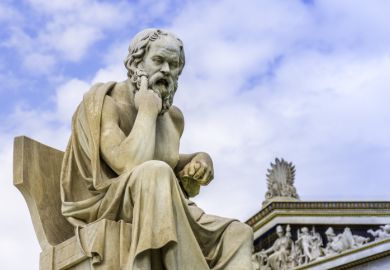What is philosophy? What is Asian philosophy? The definitions given by the editors of the Companion Encyclopaedia of Asian Philosophy in answer to these questions are in both cases broad rather than narrow. Compiled "with the intention of doing justice to the arguments, ideas, and presuppositions of philosophers working largely outside the confines of western philosophical traditions," their collection of 48 scholarly essays covers a period of some 3,000 years, from the beginning of the first millennium bce to the present day, and discusses the life and work of thinkers from regions as far apart as Spain and Japan.
The work is divided into six parts, each of which covers a specific tradition within Asian philosophy: Persian, Indian, Buddhist, Chinese, Japanese and Islamic. All six parts begin with a chapter on the origins of the tradition in question, and end with one sketching the contemporary philosophical preoccupations of the descendants of that tradition. Each part also includes a chapter on the philosophy's view of morals and society, and the parts covering Indian, Buddhist, Chinese, and Islamic philosophy contain chapters on logic and language and on knowledge and reality, some of these being among the most important - and most rigorous - chapters in the entire volume.
Not surprisingly, the editors have not always been able to distribute their material strictly in accordance with the headings of the six parts into which the work is divided. Buddhist philosophy not only has a sixth of the volume to itself; it also figures prominently in connection with Indian, Chinese, and Japanese philosophy. There is even a degree of overlap between Asian and western philosophical traditions. The major period of Islamic philosophy was when, in the ninth to the 12th centuries of the common era, Islamic ideas met those of ancient Greece, while in Japan the Meiji restoration brought with it an an enthusiasm for Comte and Mill. Contemporary Asian philosophy, in all six geographical areas, is probably unthinkable apart from the influence of Kant, Schopenhauer, Marx, Russell, Whitehead and Wittgenstein.
Besides allowing them to take account of this overlap, Brian Carr and Indira Mahalingam's broad definition of philosophy enables the contributors to the volume to write from a number of different perspectives. For Philip G. Kreyenbroeke, writing on morals and society in Zoroastrianism, the latter could be said to be a strongly philosophical religion even though in the extant tradition only a few texts of a predominantly philosophical nature are preserved. While A. Roy believes that most Indian philosophical thought depends for its main source of knowledge on the ancient thought of the Vedas, Upanisads and Vedanta, Hajime Nakamura believes that the doctrine of the Buddha is not a system of philosophy in the western sense, but a path, and Chung-yin Cheng that philosophy is developed primarily to conceptualise the ideal aspirations of a people at a certain stage or under certain specific circumstances of cultural development. Some of the Asian philosophers discussed had their own perspectives on philosophy. For example it is probable, according to Ian Richard Netton, that in the mind of al-Kindi, the "father of Arab philosophy", there was no rigid division between philosophy and theology.
Comprehensiveness is no guarantee of completeness, and despite its wealth of material the Companion is not guiltless of omissions. The most serious of these is in connection with aesthetics, on which there is not a single chapter in the entire volume. Apart from ten perfunctory lines on Buddhism and aesthetics in the chapter on contemporary Buddhist philosophy the subject is not even mentioned, and there is no reference to it in the index. The omission is particularly glaring in the case of Indian philosophy, which boasts a remarkably rich tradition of thought on aesthetics to which a succession of Hindu, Buddhist, and Jain thinkers made valuable contributions. Similarly in the 11 chapters of part two, covering Indian philosophy, there is no mention of the important Trika system of Kashmir Shaivism. Nor are these the only omissions in this part. Sarasvati Chennakesavan and K. Vasudeva Reddy's rather sanitised account of the caste system, in the chapter on morals and society in Indian philosophy, makes no mention of untouchability, while A. Roy, writing on contemporary Indian philosophy, fails to mention either M. N. Roy, India's leading Marxist thinker, or her most radical reformer, B. R. Ambedkar, whose social and political ideals have affected the lives of millions of his countrymen. Roy also fails to mention Tagore, even though Sarvepalli Radhakrishnan, to whom four pages are devoted, has written a book with the title The Philosophy of Rabindranath Tagore. Admittedly Tagore was not a systematic thinker, but then neither were Vivekananda or Gandhi, to both of whom space is devoted in this chapter.
M. N. Roy, Ambedkar and Tagore are not the only ones who fail to receive their due. Francis Soo, writing on contemporary Chinese philosophy, mentions the names of Ouyang Jingwu and Master Taixu, the most notable of the Chinese philosophers who have devoted their efforts to the development of Chinese Buddhism this century, but he does not discuss their work, on the grounds that Indian and Chinese Buddhism are dealt with in chapters 17 and 28 of the encyclopaedia. Perhaps due to an editorial oversight, not only are the two philosophers not discussed in these chapters, they are not even mentioned there, nor do their names appear in the index. There are other inconsistencies, as well as a few misprints. Although anatta is correctly defined in the glossary, as "the doctrine that there exists no permanent, independent partless self underlying impermanent phenomena", the editors choose to render the term, in their introduction to part two of the encyclopaedia, as "no consciousness", which is patently absurd. They have also chosen to adhere to the convention bc and ad for all dates. In a work devoted to Asian philosophy bce and ce would surely have been more appropriate.
According to the publishers, the volume is crucial for students and scholars working in philosophy, theology, and a variety of area studies, including Asian, Indian, and Middle East studies. Probably they do not exaggerate. Many of the volume's users will no doubt be content to dip into it occasionally, whether in connection with their own academic work or simply to extend their knowledge, and indeed the encyclopaedia is designed, in the words of the editors, as a reference volume for students, scholars and others who require more than just a simple sketch of "oriental" ideas. But perhaps the best use of the work, if one had time and the intellectual stamina, would be to read it from cover to cover, to provide a superb education in Asian philosophy. One would not only encounter many different philosophies (indeed, many different conceptions of the nature of philosophy), but also all the major religions of Asia, as well as seeing the different ways in which the philosophies and religions have interacted over the centuries. It might even be argued that the process of interaction, in Asia, between these two great areas of human experience that in the West are designated "philosophy" and "religion" forms the encyclopaedia's major unifying theme.
Be that as it may, there is little doubt that philosophers in Europe and the Americas are beginning to take a serious interest in Asian philosophy, even as their counterparts in Asia have for a century or more taken a serious interest in the philosophy of the West. The appearance of the Companion Encyclopaedia of Asian Philosophy is thus a sign of the times. Together with the Oxford academic Journal of Asian Philosophy, also co-edited by Carr and Mahalingam, and the same scholars' European society for Asian philosophy, as well as the research centre for Asian philosophy at the University of Nottingham, it will be a means of contributing to the further growth of an interest of which it is itself a manifestation. The day will soon come, I hope, when it will no more be possible for the European student of philosophy to ignore Nagarjuna, Sankaracarya, or Avicenna than it is possible to ignore Plato, Kant or Schopenhauer.
Urgyen Sangharak****a (D. P. E. Lingwood ) founded the Friends of the Western Buddhist Order and is the author of more than 40 books, mainly on Buddhism.
Companion Encyclopedia of Asian Philosophy
Editor - Brian Carr and Indira Mahalingam
ISBN - 0 415 03535 X
Publisher - Routledge
Price - £95.00
Pages - 1,136
Register to continue
Why register?
- Registration is free and only takes a moment
- Once registered, you can read 3 articles a month
- Sign up for our newsletter
Subscribe
Or subscribe for unlimited access to:
- Unlimited access to news, views, insights & reviews
- Digital editions
- Digital access to THE’s university and college rankings analysis
Already registered or a current subscriber?



